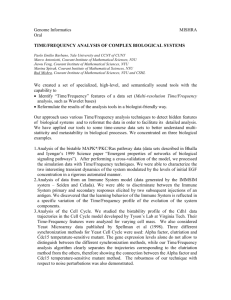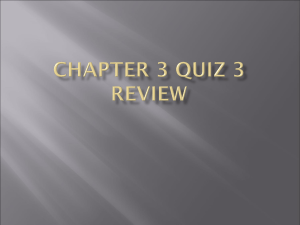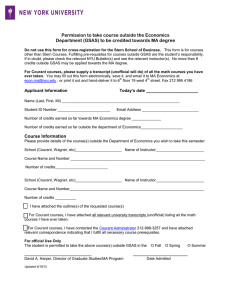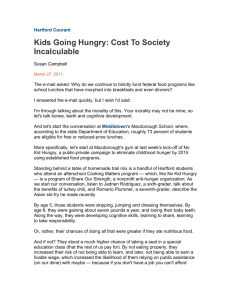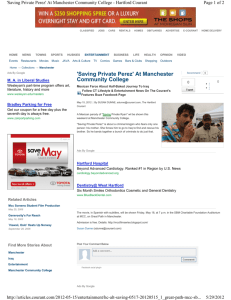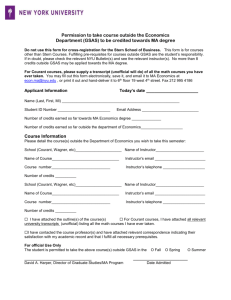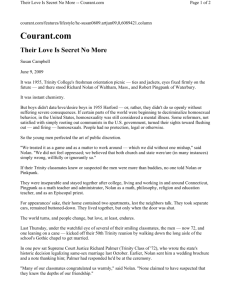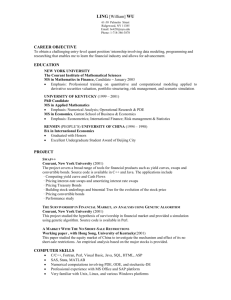Raghu Varadhan Receives National Medal of Science r tte
advertisement
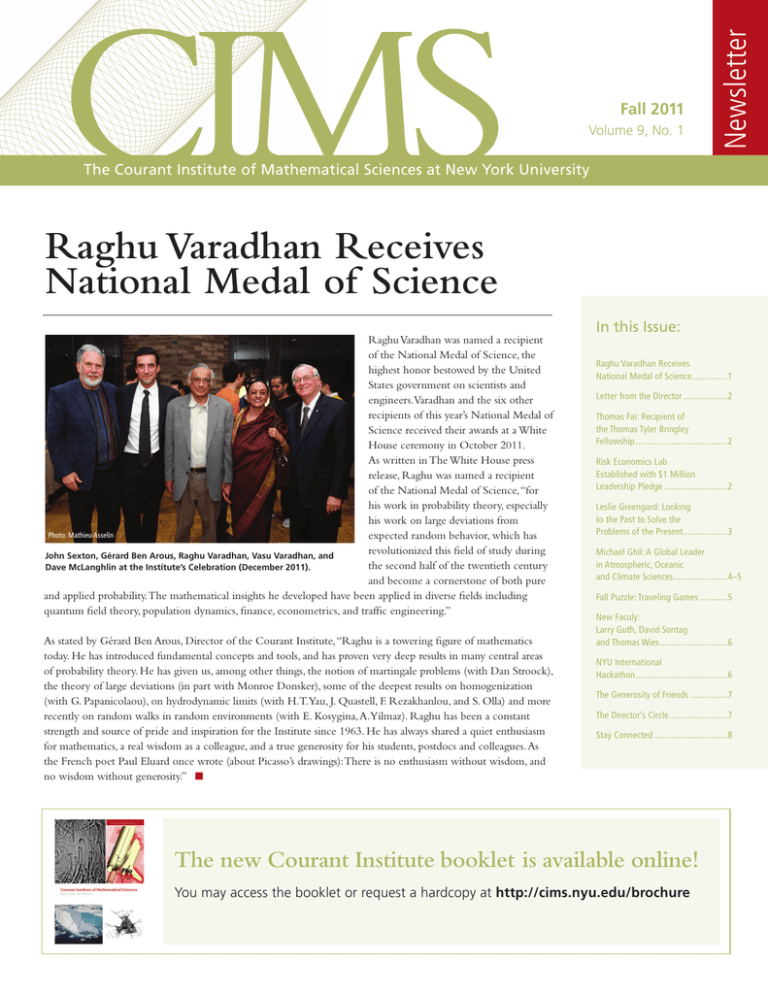
Volume 9, No. 1 Newsletter Fall 2011 The Courant Institute of Mathematical Sciences at New York University Raghu Varadhan Receives National Medal of Science Raghu Varadhan was named a recipient of the National Medal of Science, the highest honor bestowed by the United States government on scientists and engineers.Varadhan and the six other recipients of this year’s National Medal of Science received their awards at a White House ceremony in October 2011. As written in The White House press release, Raghu was named a recipient of the National Medal of Science, “for his work in probability theory, especially his work on large deviations from Photo: Mathieu Asselin expected random behavior, which has revolutionized this field of study during John Sexton, Gérard Ben Arous, Raghu Varadhan, Vasu Varadhan, and the second half of the twentieth century Dave McLanghlin at the Instítute’s Celebration (December 2011). and become a cornerstone of both pure and applied probability. The mathematical insights he developed have been applied in diverse fields including quantum field theory, population dynamics, finance, econometrics, and traffic engineering.” As stated by Gérard Ben Arous, Director of the Courant Institute, “Raghu is a towering figure of mathematics today. He has introduced fundamental concepts and tools, and has proven very deep results in many central areas of probability theory. He has given us, among other things, the notion of martingale problems (with Dan Stroock), the theory of large deviations (in part with Monroe Donsker), some of the deepest results on homogenization (with G. Papanicolaou), on hydrodynamic limits (with H.T.Yau, J. Quastell, F. Rezakhanlou, and S. Olla) and more recently on random walks in random environments (with E. Kosygina, A.Yilmaz). Raghu has been a constant strength and source of pride and inspiration for the Institute since 1963. He has always shared a quiet enthusiasm for mathematics, a real wisdom as a colleague, and a true generosity for his students, postdocs and colleagues. As the French poet Paul Eluard once wrote (about Picasso’s drawings): There is no enthusiasm without wisdom, and no wisdom without generosity.” n In this Issue: Raghu Varadhan Receives National Medal of Science................1 Letter from the Director....................2 Thomas Fai: Recipient of the Thomas Tyler Bringley Fellowship........................................2 Risk Economics Lab Established with $1 Million Leadership Pledge............................2 Leslie Greengard: Looking to the Past to Solve the Problems of the Present....................3 Michael Ghil: A Global Leader in Atmospheric, Oceanic and Climate Sciences........................4–5 Fall Puzzle: Traveling Games.............5 New Faculy: Larry Guth, David Sontag and Thomas Wies..............................6 NYU International Hackathon........................................6 The Generosity of Friends.................7 The Director’s Circle..........................7 Stay Connected................................8 The new Courant Institute booklet is available online! You may access the booklet or request a hardcopy at http://cims.nyu.edu/brochure Letter from the Director Dear Friends, As we approach another holiday season, it is a remarkable time to be at the Courant Institute. We are very grateful for the five-year term that Leslie Greengard has just completed in this role; we were all impressed by his leadership and incontestable good nature. Learn about the research he will now have more time to focus on in a special article (page 3). Leslie has been an important part of the life and history of Courant for over twenty years, so it is fitting that his final year coincided with the 75th Anniversary of the Institute, which was a great occasion for inviting many distinguished friends to join us for lectures, talks, and the camaraderie for which the Institute is known and loved. We now look forward to the next 75 years, which has begun with the exceptional news that Raghu Varadhan, who has been at Courant for nearly 50 years, received the National Medal of Science. NYU is facing new opportunities in 2012. Two of the most important NYU Initiatives to which the Institute is pleased to contribute are (1) building the Global Network University, including our two portal campuses at NYU Abu Dhabi and NYU Shanghai; as well as (2) strengthening Science and Engineering through new and sustained efforts, including the integration of NYU-Poly. A major project will be a University-wide initiative on Data Sciences and Statistics. This Initiative, which has been proposed and will be carried by the Courant Institute, will be led by our colleague Yann LeCun. The research at Courant continues to be broad, exciting, and at the forefront of scientific thought. The Courant Institute Holiday Lecture, given by Associate Professor Chris Bregler, explored how the wisdom of large online crowds has been utilized to overcome challenges in Computer Vision and Motion Analysis, and may even outperform human perception. Our student and postdoctoral graduates continue to be a source of pride for the Institute. We are delighted to share the enclosed article about the successful career of Courant alumnus and climate scientist Michael Ghil (page 4). While our curriculum continues to exemplify interdisciplinarity as championed by Richard Courant himself, we apply constant vigilance to preparing our students in today’s quickly evolving world. To this end, we have recently introduced several new classes, including, in Mathematics, the core class applied mathematics and applied stochastic processes and regular classes such as data analysis, mechanics, complex and biological fluids, and Monte Carlo methods; and in Computer Science, courses such as Machine Learning, Computational Photography, Probabilistic Graphical Models, and Rigorous Software Development. The life of the Institute continues to thrive because of the grants and gifts that we receive. Gifts to our Annual and Fellowship Funds provide support to our students, refurbish our student and community spaces, bring scientists from around the globe into our lecture halls, support the work of our world-class faculty through endowed chairs, and much more. So to close, I send thanks on behalf of the Institute and hope that you enjoy the small selection of news offered in this newsletter. We wish you all a warm and happy holiday season. Gérard Ben Arous 2 Thomas Fai: Recipient of the Thomas Tyler Bringley Fellowship Risk Economics Lab Established with $1 Million Leadership Pledge The Thomas Tyler Bringley Fellowship was established in memory of Thomas Tyler Bringley (1981-2008), and the first recipient is Thomas Fai. His research focuses on developing numerical methods to simulate the interaction of elastic bodies with heterogenous fluids. Red blood Thomas Fai cells, for example, occupy a large fraction of the blood by volume and have membranes that undergo large deformations as the red cells squeeze through small capillaries in the human body. These cells contain fluid that has different properties from those of the surrounding blood plasma. Fai is working on the description of these and other similar biological phenomena with mathematical models, and also on computational techniques, including parallel processing and adaptive mesh refinement, to enable efficient simulations. The hope is that this research will have medical applications one day. n The Risk Economics Lab for Decision Metrics has been established at Courant with a $1 million leadership pledge from the David K. A. Mordecai and Samantha Kappagoda Charitable Trust. The RiskEcon Lab, housed within the newly created Center for Computational Economics and Algorithmic Data Analytics, will apply a range of computational methods to researching geopolitical and socioeconomic issues, such as aging and health trends, immigration, and consumer behavior. “By tying together our leadership in applied mathematics and computer science with university-wide strengths in the sciences, the social sciences, and the professional schools, we have the opportunity to develop a unique facility at NYU,” said Courant Professor Leslie Greengard. “Among the key technologies in understanding the dynamics of socioeconomic and financial systems are machine learning, scientific computing, and statistics, as well as database and security systems— all active areas of research at Courant.” n Leslie Greengard: Looking to the Past to Solve the Problems of the Present by M.L. Ball In October of this year, Leslie Greengard was awarded the Wilbur Lucius Cross Medal from the Yale Graduate School Alumni Association, having earned his M.D. and Ph.D. in Computer Science from the Yale Graduate School of Arts and Sciences in 1987. In the award program’s salutation, Greengard is hailed as “one of the world’s Photo: Cheryl Sylivant leading applied mathematicians and computational scientists. The fast multipole method (FMM), which he introduced with his colleague Vladimir Rokhlin, was cited by the American Institute of Physics and the IEEE Computer Society as one of the top ten algorithms of the twentieth century.” Additional honors include the American Mathematical Society’s Steele Prize, shared with Professor Rokhlin, and election to the National Academy of Sciences and the National Academy of Engineering. In 2010, Greengard was named one of eleven National Security Fellows by the Department of Defense to conduct next-generation research projects as part of the DoD’s National Security Science and Engineering Faculty Fellowship (NSSEFF) program. He is also one of the Principal Investigators of the Courant Mathematics and Computing Laboratory, together with Marsha Berger. Mixing classical analysis with modern computing Having recently completed a five-year term as Director of the Courant Institute, one might assume Leslie Greengard would want to put his feet up for awhile. Not at all. Freed from his administrative duties, Greengard can now return to his fundamental passion, which he describes as “mixing a very classical style of analysis with modern computational techniques.” As explanation, Greengard said, “In talks that I give for a broad mathematical audience, I often make two observations. The first is that scientific computing for problems in fluid dynamics, electromagnetics, acoustics, heat transfer, et cetera evolved over the last fifty years by directly mapping the equations being solved to their discrete counterparts. Mathematical analysis was used largely to understand the behavior of those discrete equations in terms of issues such as order of accuracy and stability. however, driven by the remarkable increase in computer power and storage, it became interesting and timely to consider the question of ‘computational complexity.’ That is, how does the cost of an algorithm grow with problem size? Driven initially by questions in electrostatics and electrodynamics,Vladimir Rokhlin and I were led to the development of what are now called analysis-based fast algorithms, including the fast multipole method.” Greengard continued, “This brings me to my second observation, which is simply that to achieve this improvement, we returned to the 19th and early 20th century attitude: building specialized methods geared to specific problems.” When faced with a new computational problem in continuum mechanics or physics, the usual approach is still to discretize the governing partial differential equations and use linear or nonlinear algebraic methods to solve them, according to Greengard. “In many cases, however, there is a rich mathematical history that can be brought to bear to convert the differential equation into an integral equation,” he said. “Those are the problems I concentrate on, with a large part of the effort aimed at investigating what aspects of classical analysis, mathematical physics and geometry can be brought to bear. A surprising side effect,” he added, “is that we sometimes end up exposing new mathematical questions in this search.” The past as the key to the future Describing what he sees as the future of this old-yet-new approach to scientific computing, Greengard said, “We’ve gotten to the point only in the last decade where things which really didn’t look like they were computable at all are now within range. That’s a big step forward. The next step, which I think will happen in the next decade, is that people are going to figure out how to incorporate those ‘historic’ tools into design. There’s a big difference between solving a problem once and solving it thousands of times inside an optimization loop,” he said. What’s next on the horizon “I tend to concentrate for the moment on a handful of key equations that are ubiquitous in science and engineering. There is still a long way to go,” he explained. “Finding the most suitable representations, developing the analytic infrastructure, creating the necessary fast algorithms, implementing those algorithms in software, and extending the range of models to which integral equation-based methods can be effectively applied are all areas of research that are in rapid flux.” n “That made sense initially, because for small-scale problems it is a very reasonable strategy,” he said. “About twenty-five years ago, 3 Michael Ghil: A Global Leader in Atmospheric, Oceanic and Climate Sciences by M.L. Ball Next spring at the Annual Meeting of the European Geosciences Union (EGU), Michael Ghil will receive the Alfred Wegener Medal & Honorary Membership of the EGU. This highly esteemed award is bestowed upon “those scientists who have achieved exceptional international standing in atmospheric, hydrological or ocean sciences, defined in their widest senses, for their merit and their scientific achievements.”¹ A life spent on the move and studying movement When a National Research Council (NRC) staff member was trying to summarize why Michael Ghil should sit on one of the NRC committees that advises the U.S. government on funding research, she said without hesitation, “If it moves, Michael models it.” An extraordinarily accomplished professor of Atmospheric, Oceanic and Climate Sciences, Professor Ghil clearly not only likes things that move, he likes to move himself, splitting his time between Los Angeles (Distinguished Professor of Atmospheric Sciences and Geophysics at UCLA) and Paris (Distinguished Professor of Geosciences at l’École Normale Supérieure, the renowned ENS). From Hungary to Transylvania to Israel to Courant Born in Budapest in 1944, Ghil fled Nazi-controlled Hungary as a baby in his mother’s arms, settling in a small town in Transylvania. In 1963, he immigrated to Israel, earning his B.Sc. and M.Sc. in Mechanical Engineering at Technion-Israel Institute of Technology. In 1971 he entered the Courant Institute (choosing it over Berkeley and the University of Minnesota), receiving an M.S. and Ph.D. in Mathematics. “I originally came to be Joe Keller’s student but Joe had too many students at the time so I became Peter Lax’s student, also a Hungarian,” Ghil said. “In fact, I did not discover until after becoming Peter’s student that our families knew each other in Hungary. My uncle was Edward Teller, the physicist. His mother and my grandmother were sisters. The Teller family and the Lax family knew each other and even vacationed together.” In describing the Institute, Ghil recalled that “Courant was really an incredible place to learn mathematics. There’s a certain Courant style that is very different from the way mathematics is done and taught elsewhere. Paris has the greatest doctoral school of mathematics in the world and the largest concentration of mathematicians. It’s very formal mathematics, Bourbaki-style, though – Courant is exactly the opposite.” Chair of the Atmospheric Sciences Department at UCLA After receiving his doctorate from Courant in 1975, Ghil spent a year as an NRC Resident Research Associate at NASA. At the same time, he was an Adjunct Assistant Professor at Courant and an Adjunct Assistant Professor in the Geological Sciences Department at Columbia. He then returned to Courant fulltime and stayed for ten more years before heading west. In 1988, Ghil became Chair of the Department of Atmospheric Sciences at UCLA, then from 1992-2004, was Director of the Institute of Geophysics and Planetary Physics, a highly interdisciplinary institute. “I like to describe it as the Courant Institute of the geosciences,” he said. “We all have joint appointments between the Institute and the various teaching departments in the Physical, Life and even Social Sciences.” Head of the Geosciences Department and founding Director of the Environmental Research and Teaching Institute at the ENS Ghil’s current Professorship at the ENS is the outcome of a minisabbatical in 1979. His future wife (whom he would meet the next year in New York where she was teaching at the Lycée Français), who is French, was a student in the Humanities there. “After several more visits, I became in 2002 the first ENS professor of Atmospheric, Oceanic and Climate Sciences,” he said. “The ENS essentially created this Chair for me, and also appointed me Head of the Geosciences Department and founding Director of the Environmental Research and Teaching Institute. Now I’m a happy man because as of October of last year, I don’t have to do any of those administrative things anymore! I’m just doing research and some teaching.” Using dynamics to model the atmosphere and oceans One of the originators of theoretical climate dynamics, Ghil explained his current research as thinking about the entire climate system as a dynamical system, formulating problems along these lines and trying to solve them. “One of the classes of problems that arise is how to combine partial measurements of the atmosphere and oceans with the equations in order to get a better movie of the atmosphere and oceans ¹ European Geosciences Union (www.egu.eu/awards-medals/awards-and-medals/award/alfred-wegener.html) 4 Continued from pervious page Andy Majda, Professor of Mathematics and The Samuel F. B. Morse Professor of Arts and Science at the Courant Institute, stated that Michael is “well-known in the atmosphere ocean climate community as one of the first advocates of Kalman filtering for data assimilation and ideas from bifurcation theory and chaos for nonlinear dynamics.” global warming impact it. “I had the opportunity to work with a very bright young man who was doing his Ph.D. in economics when I got to the ENS in 2002,” Ghil explained. “I taught him dynamical systems and he taught me economics, which was not easy because I had to learn a whole new set of symbols and jargon. But we did some good work together and I learned a lot and it was a lot of fun. The only difficulty,” he remarked, “is getting economists to believe that anybody who is not a named-chair professor in economics at Princeton or Harvard can do something useful.” Studying the impact of extreme events on the economy Recently, Ghil became interested in how the economy works as a dynamical system and how extreme events, natural catastrophes and In today’s unsteady climate of extreme events – atmospheric, economic and political – it hopefully will prove to be of inestimable value that Michael Ghil loves to study things that move. n in motion,” he said. “In particular, I’ve led the applications of sequential estimation or Kalman filtering to this area. Incidentally, Rudolf Kálmán is another Hungarian who fled the country during WWII.” Puzzle | Fall 2011 Traveling Games by Dennis E. Shasha, Professor of Computer Science This puzzle concerns a game between travelers and hotel owners. Monopolies arise in strange places. An empty hotel room represents a lost opportunity to the hotel owner. The marginal cost of cleaning a room is near zero given the fixed cost of the personnel, rent, and so on. So, the hotel has every interest in filling all its rooms. Clever travelers can take advantage of this by waiting till the last minute to buy cheap rooms. Of course, they run the risk that they may not sleep anywhere. The result is a game. Let’s work up to the game in stages. hotel reasons the same way, then there will be six rooms for six travelers, each costing $100 per night. Note how much better this is for consumers. Warm-up 3: The hotel owners approach an agent to set room prices for both of them. They agree to give the agent 10% of any extra profit they would make beyond the $300 each currently receives. How much can they increase their profit? Solution: If the agent sets prices at $200 per room instead of $100, then profits at each hotel will increase to $400 while leaving two customers without rooms. As far as the hotels are concerned, the agent has earned his 10%. Customers are less happy. A single agent (whether online or not) can be as bad for consumers as a hotel monopoly. Here are the questions for you: Warm-up 1: Suppose you own the only hotel in town. You have three vacant rooms for tonight. You know from history that there will be one visitor who is willing to spend $300 per night, another at $200 per night, and one at $100 per night. We’ll abbreviate this demand profile to 1 @ $300, 1 @ $200, 1 @ $100. If you have to give the same price to all comers, what should you set your price to be? 1. Given a demand profile and a certain number of rooms, try to find the price per room that will maximize profits if you control all six rooms in a town. If the demand profile is x @ $300, y @ $200, and z @ $100, for which positive values of x, y, and z would you set the price for your six rooms at $100 and for which would you set the price at $300? Solution to warm-up 1: $200 -- you get $400 and leave one room empty. 2. If you control all the rooms in town, is there ever some values of x, y, z for which you receive more profit by charging $250? Suppose there are two hotels next to one another of the same quality and the demand is twice that before, viz. 2 @ $300, 2 @ $200, 2 @ $100. Now if your hotel sets the price at $200, the other hotel can set the price at, say, $180 and get three guests out of the four willing to pay at least $200. You may receive as little as $200 and you leave two rooms empty. 3. If there are two virtually identical hotels on the same block each having three rooms, but you control the rooms of only one and the demand profile is again x @ $300, y @ $200, and z @ $100, then for which x, y, and z values would you charge $200 to guarantee as much revenue as possible? For which x, y, z would you charge $300? Warm-up 2: If you don’t know how much the other hotel will charge, then what can you guarantee to obtain? 4. In the case that we have 2 @ 300, 2 @ 200, and 2 @ 100 and you have just one of the two identical hotels, how much more might you profit if you knew what your competitor charged? Solution to warm-up 2: If your hotel charges $133 and the other charges more, then you will fill your three rooms and still get an effective $400. On the other hand, if the other hotel charges less than $133, then you may receive as little as $133 (just one of the four who is willing to pay $200 or more). But, if you charge $100, you will guarantee an income of $300. If the other Does this change if those who are willing to pay more book later? For the solution, email: courant.alumni@nyu.edu 5 New Faculty NYU International Hackathon Larry Guth’s research interests include metric geometry, harmonic analysis, and geometric combinatorics. He received his PhD from MIT in 2005. He was a postdoc at Stanford and an Assistant Professor at the University of Toronto. He received a Sloan fellowship in 2010. Larry Guth David Sontag Thomas Wies David Sontag obtained his PhD from MIT in 2010, followed by a postdoc at Microsoft Research. His research interests are in machine learning, large-scale statistical models, and approximation algorithms for probabilistic inference. He is particularly interested in applications in medicine, and is currently designing algorithms for early detection of sepsis in the ER. Thomas Wies’ research is in formal methods and verification of computer systems. He is specifically interested in program analysis, decision procedures for automated deduction, and the use of these techniques in software productivity tools. He was awarded a Microsoft Research European PhD Scholarship and two fellowships from the German Research Foundation. Design: Chien Lun Hung Photo: Chien Lun Hung (Right) NYUAD sophomore in Computer Science Juan Felipe Beltrán and Saná Odeh at the first NYUAD Hackathon New York University Abu Dhabi (NYUAD) hosted computer science students, academics, and technology experts from around the globe to participate in the first ever International Hackathon for the Social Good in the Arab World. During the three-day event, more than 50 students worked in teams to create mobile and web applications designed to tackle real-world social issues in the region. An NYUNY team won second place (congratulations to Max Stoller and Tengchao Zhou, and to their teammate Monir Abu Hilal from Princess Sumaya University for Technology in Jordan), and an NYUAD team was in third place (congratulations to Katy Blumer, Alice Tessen, Ali Taqi, Nishant Mohanchandra, and Halim Lagrid). The NYUAD Hackathon was organized by Saná Odeh, a clinical faculty member at NYUNY, currently teaching at NYUAD. The Hackathon was designed to foster a culture of innovation, collaboration and entrepreneurship in computer science, while providing students the opportunity to interact with international technology experts, entrepreneurs and venture capitalists, who included faculty from participating universities and professionals from organizations including Yahoo!, Grameen Foundation, LinkedIn, Microsoft Corporation, and the World Bank. n The Generosity of Friends Donations from friends and alumni of the Courant Institute greatly assist our educational and research missions. Your donations to the Courant Annual Fund are more important than ever. This unrestricted income supports students and their conference travel, enhances the activities of our student clubs, and helps fund the cSplash and WinC outreach programs. The Annual Fund provides matching funds to secure grants from other sources, enables the Institute to invite distinguished speakers for both technical and public lectures, and assists in creating improved public spaces in both Warren Weaver Hall and the Broadway building. Please join the Courant Director’s Circle with a donation of $1,000 and above. This entitles you to join special events at the Institute, including a Circle only event in the fall, and the exclusive Director’s Toast before the holiday party.Your donation will help support a truly extraordinary range of scientific and educational initiatives. n 6 The Courant Institute recognizes with gratitude the following alumni, faculty, and friends who have made gifts from Sept. 1, 2010 to present: Up to $499 Hans Aberg Juan Carlos Aguilar Gavin M. Aiello Gennady P. Aizenberg Emre Rifki Furutani Aksay Salvatore Anastasio Sara Landis Angrist Siddhartha Annapureddy Janis Elia Archer Julius A. Archibald, Jr. Jeffrey P. Aronowitz Gordon A. Assing Jeffrey M. Augenbaum Robert E. Ayache Evan C. Ayala Paul M. Bailyn Jonathan J. Baker Bernard C. Baldwin Lance M. Ball Wayne W. Barrett Daniel John Baumbach Stanley M. Benson Neil E. Berger Lucas M. Bernard Eli Bernstein Geoffrey C. Berresford Daria J. Bielecki Nurit Binenbaum David J. Birnbaum Albert A. Blank Andrew E. Borthwick Craig Seth Brass Marian Woertz Brawer Robert C. Brigham Robert F. Brodsky Neil B. Bromberg Ryan H. Brothers Samuel S Bucholtz Mr. and Mrs. Mark Cane Paul J. Capobianco Judith Carlin John Morrison Carpenter Danielle Denice Cauthen Jianer Chen Mou-Ta Chen Alexey Chentsov Jen-Lung Chiu Philip Chung Richard J. Cole Christopher Lee Conway Benoit Couet Laura Beth Cruz Amnon Dalcher Teymour T. Darkhosh Sharmista R. Das Florin David Thomas K. DeLillo Anastasios Demetrakopoulos Chabilall Deochand Gurdeep Singh Dhindsa Sidney P. Diamond Donald J. Dixous Robert E. Dowd Pierre Louis Edouard Drogoul Zvi Dubin Kabir Dutta Jan S. Edler Yevgeniy Eltsufin Thomas J. Emerson Raymond Stuart Ennis Frank Ethridge Tseng Ming Fan Daniel J. Farkas Xiaosong Feng Elaine D. Fernandes Teobaldo A. Fernandez Richard D. Feuer Spencer A. Fine Norman J. Finizio Craig Fithian Thomas R. Flack Andrew B. Flint Catalin Floristean Daniel B. Forger, Jr. Richard Foy Craig A. Friedman Mark D. Galit Laura M. Gellert Sergei M. German Amy B. Gideon Henry V. Goldstein Anatoliy Goroshnik Dmitry Goykhman Arvin Grabel Samuel M. Graff Elizabeth C. Graham Barry Granoff Alan T. Gray Anthony E. Gray Andrew J. Green Kenneth G. Grossman Jonathan Christopher Gruhl Jose A. Guerra Pierre-Yves M. Guillo Mr. and Mrs. Sidney Halem Milton Halem James Han Zheng-Chao Han Richard D. Hannes David Blake Harrison Keith Harrow Madeline Trieger Harrow Dalia Navon Hartman Miriam Hausman Beatrice Loerinc Helft Tali Herman David Hertzberg Bernhard Hientzsch Robert K. Hillman Michael J. Hind Darshit Suresh Hirani Jiang-Yi Ho Shean-Lan Ho Pearl R.S. Hochstadt Toby W. Hollenberg Frank C. Hoppensteadt Brian P. Hotaling Devjani Huggins Socrates Ioannidis Barry E. Jacobs Steven Jaffe Rita S. Jain Tharun Jacob John Will H. Jolley Frank P. Jones Melissa A. Jurist Robert H. Kagel Charles S. Kahane Jay M. Kappraff Muriel Karlin Talbot Michael Katz Robert F. Kelly Eric Y. Kemperman Mary B. Kerins Barbara Lee Keyfitz B. Melvin Kiernan Hui K. Kim Hyun Jae Kim Robert J. Kirby Evelyn M. Kirschner Morris M. Klein Paula Shafran Koerte Rungporn Koohasaneh Evan M. Korth Lucien F. Kraner Herbert C. Kranzer Sam Krinsky Arvind Reddy Krishnappa Trishank Karthik Kuppusamy Nigel S. Kwok Edward B. Lacher Gerasimos E. Ladas Julian D. Laderman Karven Lam Elizabeth A. Lamm Sebastien Lamy de la Chapelle Arnold Lapidus Eugene Manual Laska Mark Daniel Lavin Nam Le Irene Huen Lee Sai Wah Lee Pil Hwa Lee Claudia Leme Peter V. Lessek Brian R. Lessing C. David Levermore Bernard W. Levinger Dylan H. Lewis Ninghui Li Anwei A. Li Chen Li The Director’s Circle Chia-Ming Lin Arieh Listowsky Walter Littman Steven Liu Kai Ju Liu Donald W. Loveland Mihaela M. Mack Charles G Major Gabrielle Maloney-Tobin Kurt Maly Edward Man Matthew Manilow Rev. Paul R. Manning Max Martinez Karen D. Martinez Tarek P. Mathew Telly Mavroidis Anne-Claire McAllister Donald J. McCarthy Kevin B. McGrattan Margaret Ellen Meurer Charles A. Miglierina Joseph S. Miller Dorothy G. Mitchell Thanasis I. Mitsolides Van John Molino Raymond Enrique Moradel Srinath Nathan Harlan E. Nebenhaus Joyce A. Newman Stuart B. Newman Joshua A. Newman Kam Chuen Ng Lawrence A. Noble Casey Edward O’Meara Harold Z. Ollin Thomas J. Osler Jacek Ossowski Ming Pan Karen A. ParchemCorbman Jiyeon Park Wole K. Parks Andras Pataki Barry S. Peckoff Irene Peltzer Jianbo Peng Michael A. Perlman William Pierce Cory J. Plock Julian F. Prince Karla J. Printz Ajay Rajkumar Matthew L. Rajpolt Charles Andrew Reich Hella Reitman Charles Wesley Rice John M. Rinzel Christopher Alexande Robbins Nicholas J. Rose Rochelle S. Rosenfeld Patricia A. Rotello Lawrence Thomas Ryan Robert L. Sachs Fatema Adnan Saifee Peter M. Sbashnig Richard E. Schantz Lorin Schneider Victor S. Schneider, M.D. Diana Robinson Schwartz Miss Abby Schwartz Jonathan Schwartz Bernard D. Seckler Evelyn Mehler Seckler Thomas I. Seidman Francois-Jerome Selosse Bohdan Sereda Prashant Harivadan Shah Arnold Shak Harold D. Shane Micha Sharir Seymour Sherman Arthur S. Sherman Neil Prabhakar Shetty Jianjun Shi Joseph K. Shraibman Harold Shulman Ilya Shutman Evan J. Siegel Michael S. Siegel Barry M. Singer Nitin Singla Ramlala P. Sinha Robert A. Smith Jonathan A. Smith Brian G. Smith Martin A. Snyder John M. Snygg Christina A. Sormani Meredith N. Springer Michael St.Vincent Joan Low Stachnik Benjamin D. Statz James K. Steadman Eric Lawrence Stedfeld Joseph Steinberg Gladys Cohen Steinberg Robert A. Sternhell Benjamin Chaim Storch Keith L. Stransky Cheryl Sylivant Jean Taylor Edward H. Theil Justin Armin Thomson Charles Tier Curt A. Tilmes George L. Trakas Bernard R. Traphan Wai Hon Tsui Ling C. Tu Jay Turim Alexander S. Tuzhilin Julius J.Vandekopple Rohin R.Vazirani Charles A. von Urff Thomas M. Wagner Yulin Wang Chia-Chie Wang Junhua Wang Chien-Po Wang Jiaxin Wang Donald R. Warren Henry Weinberg Eugene Weinstein Abraham S. Weishaus Bonita Katz Weiss Dr. and Mrs. Norman Weiss Benjamin P. Wellington Cliff Wei-Feng Weng Michael Williams Zofia H. Wlodarski Krzysztof M. Wlodarski Shao A. Wu Marvin Yablon Raymond J.Yatko Steve S.Yeung Ganna Zaks Anthony J. Zeppetella Xu Zhao Wei F Zheng $500-$999 Philippe G. Charles Jingming Chen Danielle Choi Douglas P. Doucette Andrea Erstling Bruce A. Esposito Paula Blankstein Esposito Robert B. Gordon Carol Hutchins Weimin Jin Susan L. Korn Mr. and Mrs. Patrick C. Lin Morris J. Meisner Neeta S. Nabar Anthony N. Palazotto Enlin Pan Stuart S. Piltch Paul H. Rabinowitz Chester B. Sensenig Amal Shamma Alan H. Stein Marsha E. Stein Guy A. Story, Jr. Maja-Lisa Wessman Thomson Burton Wendroff Kurt C. Wulfekuhler Michael Yanowitch Donald Poy Yee Bernard Kwangsoo Yoo Ernest Zhu Corporations & Foundations Accountnet, Inc. Adobe Systems Inc. Alfred P. Sloan Foundation AT&T Foundation AXA Foundation Bank of America Foundation Bill and Melinda Gates Foundation Breast Imaging Specialists, PC Chronic Fatigue & Immune Dysfunction The David K A Mordecai and Samantha Kappagoda Charitable Trust Dow Jones & Company Inc ExxonMobil Foundation Fidelity Charitable Gift Fund Fletcher Asset Management, Inc. Friends of the Int’l Mathematical Union Google Inc. Grainger, Inc. IBM International Foundation International Business Machines Corp. Jewish Communal Fund Joan & Joseph Birman Foundation May and Samuel Rudin Family Fdn., Inc. Merck Partnership for Giving Microsoft Corporation Morgan Stanley Motorola Foundation Nomura America Foundation ObjectVideo, Inc. Oracle Corporation Raytheon Company Richard Hannes Irrevocable Trust Schwab Charitable Fund Sensenig Family Trust Dtd 12-18-90 Tag Online, Inc. The Boeing Company The David and Lucile Packard Foundation The Non Nobis Solum Foundation, Inc. The Simons Foundation The Walt Disney Company Foundation United Way of New York City Universa Investments LP Vanguard Charitable Endowment Program Verizon Foundation Wells Fargo Foundation Yahoo! Inc. Please note that the above list includes companies providing matching gifts for their employees. To find out whether your employer sponsors such a program, please visit: matchinggifts.com/nyu Online Giving: giving.nyu.edu/courant We thank our Director’s Circle Members from Sept 1, 2010 to present. The Director’s Circle is the Courant Institute’s giving society for those making a contribution of $1,000 or more in a given academic year. Members receive special invitations as guests of the Director to events of interest throughout the year, with complimentary access extended where applicable. Additionally, those giving at the $5,000 level and above qualify for membership in the various university-wide giving societies. Join the 2011-2012 Director’s Circle with a gift of $1000 or more! Contact Cheryl Sylivant at sylivant@cims.nyu.edu or 212 998-3321 for details. Ernest Battifarano Gérard Ben Arous Evelyn Berezin Mr. and Mrs. Christoph Biermann Robert Buff Bruce A. Esposito Carol Ann Fugosich Norman Grossman Barbara J. Krumsiek Tomas Lajous Jie-Han Lee Melvin R. Mullin Joshua N. Newman Anthony N. Palazotto Grant Parker Susan Mary Puglia* Robert Richard Reeber Kurt S. Riedel* Chris and Billie Rorres Jeffrey M. Rosenbluth* Louis K. Salkind and Deborah Rennels* Anil K. Singh Lawrence Sirovich and Carole Hochman Sirovich Thomas C. Spencer Joseph Spinden Lu Ting Edwin Yuon Tsui Peter Alexander Vasseur Yevgeny Vilensky Benjamin S. White* Brad Wilson Zeev Wurman Robert A.Young * NYU President’s Society Members — gifts of $5,000 and above. Your gift makes a difference. 7 New York University Courant Institute of Mathematical Sciences Warren Weaver Hall 251 Mercer Street New York, NY 10012 To join our community of Courant donors, please visit the new NYU online giving page at giving.nyu.edu/courant or contact Cheryl Sylivant at sylivant@cims.nyu.edu or call 212 998 3321. Stay Connected to the Institute Join Courant’s Social Networks! The Courant Institute has an official Facebook page and two Linked In pages, which alumni are encouraged to join to stay connected to the CIMS community and informed about special events and activities. Facebook.com: Courant Institute of Mathematical Sciences Alumni LinkedIn.com: Courant Institute of Mathematical Sciences Network Mathematical Finance MS Program at Courant Institute NYUniverse (alumni.nyu.edu) NYUniverse is an online community launched by NYU Alumni Relations, with networking and other resources for alumni. Your News in the CIMS Newsletter The Courant Institute invites all Alumni to keep colleagues and friends up-to-date on life events. All items submitted (such as career achievements and family milestones) will be considered for publication in the Newsletter or online. Please send the details to alumni.news@cims.nyu.edu.
